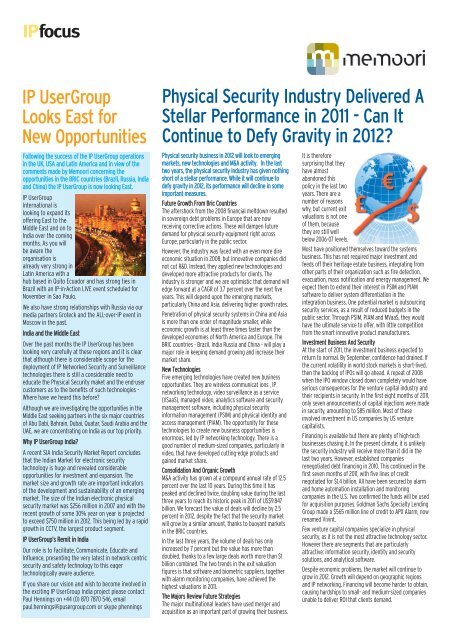IPfocus - IP UserGroup
IPfocus - IP UserGroup
IPfocus - IP UserGroup
You also want an ePaper? Increase the reach of your titles
YUMPU automatically turns print PDFs into web optimized ePapers that Google loves.
<strong><strong>IP</strong>focus</strong><br />
<strong>IP</strong> <strong>UserGroup</strong><br />
Looks East for<br />
New Opportunities<br />
Following the success of the <strong>IP</strong> <strong>UserGroup</strong> operations<br />
in the UK, USA and Latin America and in view of the<br />
comments made by Memoori concerning the<br />
opportunities in the BRIC countries (Brazil, Russia, India<br />
and China) the <strong>IP</strong> <strong>UserGroup</strong> is now looking East.<br />
<strong>IP</strong> <strong>UserGroup</strong><br />
International is<br />
looking to expand its<br />
offering East to the<br />
Middle East and on to<br />
India over the coming<br />
months. As you will<br />
be aware the<br />
organisation is<br />
already very strong in<br />
Latin America with a<br />
hub based in Quito Ecuador and has strong ties in<br />
Brazil with an <strong>IP</strong>-in-Action LIVE event scheduled for<br />
November in Sao Paulo.<br />
We also have strong relationships with Russia via our<br />
media partners Groteck and the ALL-over-<strong>IP</strong> event in<br />
Moscow in the past.<br />
India and the Middle East<br />
Over the past months the <strong>IP</strong> <strong>UserGroup</strong> has been<br />
looking very carefully at these regions and it is clear<br />
that although there is considerable scope for the<br />
deployment of <strong>IP</strong> Networked Security and Surveillance<br />
technologies there is still a considerable need to<br />
educate the Physical Security maket and the end-user<br />
customers as to the benefits of such technologies -<br />
Where have we heard this before?<br />
Although we are investigating the opportunities in the<br />
Middle East seeking partners in the six major countries<br />
of Abu Dabi, Bahrain, Dubai, Quatar, Saudi Arabia and the<br />
UAE, we are concentrating on India as our top priority.<br />
Why <strong>IP</strong> <strong>UserGroup</strong> India?<br />
A recent SIA India Security Market Report concludes<br />
that the Indian Market for electronic security<br />
technology is huge and revealed considerable<br />
opportunities for investment and expansion. The<br />
market size and growth rate are important indicators<br />
of the development and sustainability of an emerging<br />
market. The size of the Indian electronic physical<br />
security market was $256 million in 2007 and with the<br />
recent growth of some 30% year on year is projected<br />
to exceed $750 million in 2012. This being led by a rapid<br />
growth in CCTV, the largest product segment.<br />
<strong>IP</strong> <strong>UserGroup</strong>’s Remit in India<br />
Our role is to Facilitate, Communicate, Educate and<br />
Influence, presenting the very latest in network centric<br />
security and safety technology to this eager<br />
technologically aware audience.<br />
If you share our vision and wish to become involved in<br />
the exciting <strong>IP</strong> <strong>UserGroup</strong> India project please contact<br />
Paul Hennings on +44 (0) 870 7870 546, email<br />
paul.hennings@ipusergroup.com or skype phennings<br />
Physical Security Industry Delivered A<br />
Stellar Performance in 2011 - Can It<br />
Continue to Defy Gravity in 2012?<br />
Physical security business in 2012 will look to emerging<br />
markets, new technologies and M&A activity. In the last<br />
two years, the physical security industry has given nothing<br />
short of a stellar performance. While it will continue to<br />
defy gravity in 2012, its performance will decline in some<br />
important measures.<br />
Future Growth From Bric Countries<br />
The aftershock from the 2008 financial meltdown resulted<br />
in sovereign debt problems in Europe that are now<br />
receiving corrective actions. These will dampen future<br />
demand for physical security equipment right across<br />
Europe, particularly in the public sector.<br />
However, the industry was faced with an even more dire<br />
economic situation in 2008, but innovative companies did<br />
not cut R&D. Instead, they applied new technologies and<br />
developed more attractive products for clients. The<br />
industry is stronger and we are optimistic that demand will<br />
edge forward at a CAGR of 3.7 percent over the next five<br />
years. This will depend upon the emerging markets,<br />
particularly China and Asia, delivering higher growth rates.<br />
Penetration of physical security systems in China and Asia<br />
is more than one order of magnitude smaller, while<br />
economic growth is at least three times faster than the<br />
developed economies of North America and Europe. The<br />
BRIC countries - Brazil, India Russia and China - will play a<br />
major role in keeping demand growing and increase their<br />
market share.<br />
New Technologies<br />
Five emerging technologies have created new business<br />
opportunities. They are wireless communicat ions , <strong>IP</strong><br />
networking technology, video surveillance as a service<br />
(VSaaS), managed video, analytics software and security<br />
management software, including physical security<br />
information management (PSIM) and physical identity and<br />
access management (PIAM). The opportunity for these<br />
technologies to create new business opportunities is<br />
enormous, led by <strong>IP</strong> networking technology. There is a<br />
good number of medium-sized companies, particularly in<br />
video, that have developed cutting-edge products and<br />
gained market share.<br />
Consolidation And Organic Growth<br />
M&A activity has grown at a compound annual rate of 12.5<br />
percent over the last 10 years. During this time it has<br />
peaked and declined twice, doubling value during the last<br />
three years to reach its historic peak in 2011 of US$9.847<br />
billion. We forecast the value of deals will decline by 2.5<br />
percent in 2012, despite the fact that the security market<br />
will grow by a similar amount, thanks to buoyant markets<br />
in the BRIC countries.<br />
In the last three years, the volume of deals has only<br />
increased by 7 percent but the value has more than<br />
doubled, thanks to a few large deals worth more than $1<br />
billion combined. The two trends in the exit valuation<br />
figures is that software and biometric suppliers, together<br />
with alarm monitoring companies, have achieved the<br />
highest valuations in 2011.<br />
The Majors Review Future Strategies<br />
The major multinational leaders have used merger and<br />
acquisition as an important part of growing their business.<br />
It is therefore<br />
surprising that they<br />
have almost<br />
abandoned this<br />
policy in the last two<br />
years. There are a<br />
number of reasons<br />
why, but current exit<br />
valuations is not one<br />
of them, because<br />
they are still well<br />
below 2006-07 levels.<br />
Most have positioned themselves toward the systems<br />
business. This has not required major investment and<br />
feeds off their heritage estate business, integrating from<br />
other parts of their organization such as fire detection,<br />
evacuation, mass notification and energy management. We<br />
expect them to extend their interest in PSIM and PIAM<br />
software to deliver system differentiation in the<br />
integration business. One potential market is outsourcing<br />
security services, as a result of reduced budgets in the<br />
public sector. Through PSIM, PIAM and MVaaS, they would<br />
have the ultimate service to offer, with little competition<br />
from the smart innovative product manufacturers.<br />
Investment Business And Security<br />
At the start of 2011, the investment business expected to<br />
return to normal. By September, confidence had drained. If<br />
the current volatility in world stock markets is short-lived,<br />
then the backlog of <strong>IP</strong>Os will go ahead. A repeat of 2008<br />
when the <strong>IP</strong>O window closed down completely would have<br />
serious consequences for the venture capital industry and<br />
their recipients in security. In the first eight months of 2011,<br />
only seven announcements of capital injections were made<br />
in security, amounting to $85 million. Most of these<br />
involved investment in US companies by US venture<br />
capitalists.<br />
Financing is available but there are plenty of high-tech<br />
businesses chasing it. In the present climate, it is unlikely<br />
the security industry will receive more than it did in the<br />
last two years. However, established companies<br />
renegotiated debt financing in 2010. This continued in the<br />
first seven months of 2011, with five lines of credit<br />
negotiated for $1.4 billion. All have been secured by alarm<br />
and home automation installation and monitoring<br />
companies in the U.S. Two confirmed the funds will be used<br />
for acquisition purposes. Goldman Sachs Specialty Lending<br />
Group made a $565 million line of credit to APX Alarm, now<br />
renamed Vivint.<br />
Few venture capital companies specialize in physical<br />
security, as it is not the most attractive technology sector.<br />
However there are segments that are particularly<br />
attractive: information security, identity and security<br />
solutions, and analytical software.<br />
Despite economic problems, the market will continue to<br />
grow in 2012. Growth will depend on geographic regions<br />
and <strong>IP</strong> networking. Financing will become harder to obtain,<br />
causing hardships to small- and medium-sized companies<br />
unable to deliver ROI that clients demand.














